#Global water crisis and its solutions
Text
Geopolitics is not what you think.
It is interesting to me that how we view issues of global politics and how academics and certain political actors view the issues have such a huge separation.
For instance, when people view the russian invasion of ukraine, they think of a simple power grab, or they don't understand why russia would want to do that.
When i was talking to a friend, who is a geopolitical expert, about the russian war against ukraine, he pulled out a topographical map of europe. Geopolitics is the study of how geography affects politics. it is NOT a general term for international politics.

The easy answer is Russia's need for a warm water port. If you know russia's borders, you would know that all of it's major ports are in the north and they freeze in the winter. They don't have a good port in the black sea that stays unfrozen. Sevastopol is the port in Crimea. While technically Ukrainian territory, it has been controlled by Russia since 2014.
The second point he made was looking at the moutains. See the map above. Then let's look at a map of the warsaw pact

Understanding moutain ranges and how they are defensible, you start to see why NATO and the Warsaw pact involved those specific countries. it creates a natural bottle neck in Germany. This also goes into why Poland gets invaded so much. it is a flat territory without natural boundaries that makes it easy to attack, and if you want your border to be a mountain you have to go through Poland. Without the countries to make up its borders anymore, Russia lacks natural boundaries. Instead of the carpathian mountains, they have simple grassland.
Then you talk to demographers as to why russia is aggressive, you see that since the end of the cold war, russia's death rate has exceeded it's birth rate. this causes a decline in population and a "demographic crisis." the average age in russia is over 40 years old. this stagnation has rippling effects throughout the country. with an older workforce, they don't have a surplus younger generation to pay for the care of the older generation. they are experiencing migration out of the country of individuals with experience and education needed in the country. They are, in short, a nation in panic.
In the international relations field, you see discussions of the lack of political influence. Russia once held a spot as one of two superpowers in the world. a regional giant who's influence shook the way international politics operated. From 1950-1989 there were really only two countries in the world that everyone needed to pay attention to: the Soviet Union and the United States. everyone else was a pawn. There was the First world, the US and her allies, the Second World, the Soviet Union and her allies, and the Third world, the non-aligned nations. (which, by the way, is where that phrase came from. a "third world" country was thought as a country so unimportant, neither the US or USSR cared about you.) in this climate, Russian, who still held what was considered the second most powerful military in the world (though... not so much now) felt they were under appreciated. China was the emerging economic powerhouse.
This is something i went into in my IR video. (as i have an IR background)
youtube
What is amazing about all this analysis is that different fields point to different reasons as to why russia invaded. and similar analysis could be done other regions. any conflict can be analyzed in this manner. the disputes in africa are interesting because the easy answer to why there are so many wars in africa is "colonialism." and i think it does make a useful, simplified solution. but it foregoes the other realms of analysis as to why these conflicts are happening.
not sure what made me procrastinate on making a video and writing this out. i needed a break from editing. I hope you found this interesting.
121 notes
·
View notes
Text
The future of innovation and efficiency that many governments and private companies dream of runs into ecological and geopolitical limits. But AI does not rely on raw materials only during the construction of its physical infrastructures; it does so throughout its cycle. For instance, data centres and servers need large amounts of water to cool down. According to a study published in Nature in 2021, Google and Microsoft declared using respectively 15.8 billion and 3.6 billion litres of water.
We don’t know if these numbers are trustworthy. As a telling example, Microsoft has been involved in a scandal regarding the water expenditure of one of its data centres in the Netherlands. Whereas the technology company declared to the Dutch authorities that the centre consumed between 12 and 20 million litres, it transpired it was actually consuming 84 million. Meanwhile, in August 2022, Thames Water announced reviewing the water expenditure of data centres in London due to the drought scenario the capital faced that summer. While the average annual cooling system consumption of a small data centre in the US is estimated to be 25 500 000 litres, that of a person in Nigeria is 12 410 litres – 2 000 times less.
AI is also energy intensive. The more data to be analysed, the higher the energy consumption. More sophisticated algorithms, which need long computational time, consume even more. For example, it is estimated that training an algorithm to automatically produce text uses 190,000 kWh; that is, 120 times more than the average annual consumption of a household in Europe in 2020. To generate this energy, raw materials such as organic matter, uranium, coal or water, among others, are again needed.
Although some of the big tech companies claim that their energy is produced sustainably, the data shows another trend. In 2019, Greenpeace published a report about an Amazon Data Centre in Virginia (USA), which is considered to be one of the most important in Amazon’s global infrastructure. Greenpeace warned against the important growth in energy consumption in the region due to this data centre’s activities. Despite Amazon’s pledge to invest in “green” energy for this data centre, the reality is that its investment in fossil fuels has increased shamelessly. In 2021, data centres were estimated to consume 0.9-1.3% of global electricity demand. Given AI’s high energy consumption and the current energy crisis, the techno-optimistic dreams of governments and Silicon Valley’s companies could be dashed by the high price of energy.
57 notes
·
View notes
Text
The Great Salt Lake is drying up and the Republican government of Utah is doing little to save it. They constantly cave to the usual groups: agricultural interests, mining, homeowners who like spacious lawns in an arid region, and big industry.
The largest saltwater lake in the western hemisphere has been steadily shrinking, as more and more water has been diverted away from the lake to irrigate farmland, feed industry and water lawns. A megadrought across the US south-west, accelerated by global heating, has hastened the lake’s demise.
Unless dire action is taken, the lake could decline beyond recognition within five years, a report published early this year warned, exposing a dusty lakebed laced with arsenic, mercury, lead and other toxic substances.The resulting toxic dustbowl would be “one of the worst environmental disasters in modern US history”, the ecologist Ben Abbott of Brigham Young University told the Guardian earlier this year.
Despite such warnings, officials have failed to take serious action, local groups said in their lawsuit, which was filed on Wednesday. “We are trying to avert disaster. We are trying to force the hand of state government to take serious action,” said Brian Moench of the Utah Physicians for a Healthy Environment, one of the groups suing state agencies.
“Plaintiffs pray that this Court declare that the State of Utah has breached its trust duty to ensure water flows into the Great Salt Lake sufficient to maintain the Lake,” reads the lawsuit, which was brought by coalition that includes Earthjustice, the Utah Rivers Council, the Center for Biological Diversity and the Sierra Club, among others.
Political pressure has not been very effective in a state dominated by Republicans. The state's response is lukewarm at best. That's in addition to bizarre proposals.
The state’s Republican governor, Spencer Cox, has suspended new claims to water in the Great Salt Lake basin and appointed a commissioner to oversee response to the lake crisis. Last year, Utah’s legislature passed several conservation measures, including a $40m trust to support lake preservation projects. But Abbott and his colleagues, who authored a sobering report on the lake in January, found that those measures increased flows to the lake by just 100,000 acre feet in 2022. About 2.5m acre-feet a year of water will need to flow into the lake to bring it to a healthy level, the researchers estimated.
That water will likely have to come at the expense of agriculture, which takes in about three-quarters of the water diverted away from the lake to grow mostly alfalfa and hay. Cities and mineral extraction operations each take up another 9% of diverted water.
But wresting water away from agriculture is politically complicated. Officials have explored propositions to pay farmers to fallow land and use less water, though such proposals have yet to gain much tractions.
Lawmakers have also offered up a series of out-of-the-box solutions – including cloud seeding, which uses chemicals to prompt more precipitation – or building a giant pipeline from the Pacific Ocean.
Seriously, a pipeline from the Pacific Ocean? This is a classic idiotic GOP way to deal with an environmental catastrophe which doesn't get to the root of the problem.
Already, the lake has lost 73% of its water and 60% of its surface area, and is becoming saltier, threatening native flies and brine shrimp. A diminished lake may be unable to support the more than 10 million migratory birds that stop over in the region. A white pelican colony recently abandoned a nesting site on the lake, potentially due to declining water levels.
“In addition to the millions of people who live here, so many plants and animals depend on the lake,” said Deeda Seed, Utah campaigner at the Center for Biological Diversity. “The health of northern Utah’s entire population depends on the Great Salt Lake’s survival and I hope this lawsuit can help save it.”
^^^ emphasis added
Yep, take their asses to court to save the body of water which gave the state's largest city its name.
#utah#great salt lake#water levels#diversion of water#the environment#migratory birds#white pelicans#brine shrimp#republicans#utah state government#spencer cox#deeda seed#brian moench#ben abbott#earthjustice#utah rivers council#the sierra club#center for biological diversity#utah physicians for a healthy environment
13 notes
·
View notes
Text
Dubai, 10 December 2023 – Climate change is already having catastrophic impacts on many migratory animals and their ability to provide vital ecosystem services to humanity according to a major new report of the Convention on the Conservation of Migratory Species of Wild Animals (CMS), a UN biodiversity treaty.
Released today at the UN Climate Change Conference in Dubai (UNFCCC COP28), the report finds that the direct effects of climate change on many migratory species are already being seen, including poleward range shifts, changes in the timing of migration, and reduced breeding success and survival. Integral to the ecosystems they live in, migratory species support vital ecosystem services that both mitigate the impacts of climate change and increase the resilience to climatic hazards.
The study also emphasizes the urgent need to act now to help vulnerable migratory species adapt to a changing climate. Actions such as the establishment of comprehensive and well-connected networks of protected areas and other effective area-based conservation measures are crucial to support species movement in response to climate change, whilst direct human interventions, such as the translocation of vulnerable populations of species, will be needed in some cases.
Some of the key findings of the report include:
Strong evidence that global increases in temperature have affected most migratory species groups, and these impacts are mostly negative. For instance, rising temperatures are causing changes in the reproduction and survival of krill and are having a negative impact on marine mammals and seabirds that rely on krill as a key food source.
Strong evidence that climate change is impacting migratory species distribution and timing of migration. In particular, temperature increases are driving poleward range shifts and earlier migration and breeding. In some species, such as wading birds, there is a risk this will cause a mis-match between the timing of breeding and the time when prey species are most abundant.
Changes in water availability are causing the loss of wetlands and reduced river flows, which are likely to particularly impact the migration of fish and waterbirds.
Extreme climate-related events such as landslides are causing severe habitat destruction and have already been observed at some seabird breeding sites.
There is strong evidence that migratory seabirds and marine mammals will be impacted by the changes in oceanic currents which are likely to alter the nature and functioning of many marine and terrestrial ecosystems.
The study ‘Climate change and migratory species: a review of impacts, conservation actions, indicators and ecosystem services’ was commissioned by the Government of the United Kingdom of Great Britain and Northern Ireland through the Joint Nature Conservation Committee (JNCC) as a major contribution to the work of CMS on climate change, and prepared by the British Trust for Ornithology (BTO).
Biodiversity is declining globally at unprecedented rates, and climate change is one of the major drivers of this crisis. In 2021, the world’s leading biodiversity and climate scientists jointly sounded the alarm, stating that biodiversity loss and climate change mutually reinforce each other and neither will be successfully resolved unless both are tackled together. The Kunming-Montreal Global Biodiversity Framework adopted last year recognizes that nature-based solutions are essential in the fight against climate change in its Target 8. The conservation of migratory species and their habitats is an important part of the solution to both the biodiversity and the climate change crises.
Migratory species are important for ecosystem function and climate change mitigation, especially when they form a significant part of an ecosystem or aggregate in large numbers at particular times of the year. Many migratory species are related to the movement and dispersal of seeds and nutrients. Large migratory species can contribute to climate change mitigation through the decomposition of their faeces, which locks carbon into the soil or seabed, as well as through more complex processes, such as maintaining trophic webs that protect forest or seagrass beds important for carbon sequestration. Migratory species can also contribute towards climate change adaptation by enhancing ecosystem resilience; for example, seabird guano increases the nutrients available for coral reef growth, which in turn reduces coastal erosion.
The impacts of climate change on migratory species underscore the need for countries to cooperate on actions to ensure their conservation. CMS provides a vehicle for such cooperation, addressing migratory species across their range. By conserving migratory species and their habitat under CMS, countries can also achieve win-win solutions and directly contribute to the goals and targets of the Kunming-Montreal Global Biodiversity Framework and the Paris Agreement on climate change.
The launch of this major report comes in advance of the 14th meeting of the CMS Conference of the Parties, in Samarkand, Uzbekistan from 12 to 17 February 2024. This meeting will be one of the most significant global biodiversity gatherings since the adoption of the Kunming-Montreal Global Biodiversity Framework, and will address crucial conservation priorities, including priority actions to address climate change and its impacts on migratory species and their habitats.
2 notes
·
View notes
Text
COP28 was more than a summit for African nations acutely vulnerable to climate disasters despite being the least responsible for carbon pollution. Africans hoped it could be a pivotal moment where the world’s climate crisis would be confronted head-on.
That hope was almost dashed entirely but salvaged at the last minute. Early on in the negotiations to draft the final text, instead of agreeing on a fossil fuel phasedown deal, a historic commitment that would have lit the path out of Africa’s deepening climate despair, the COP28 draft agreement fell far short.
There have been important strides taken by the host nation. Before the summit, the United Arab Emirates had pledged to achieve net-zero carbon emissions by 2050, the first Middle Eastern country to do so. And the UAE’s COP28 presidency put forward an ambitious agenda, mobilizing nearly $84 billion in funding and launching a $30 billion catalytic fund, Altérra, to mobilize up to $250 billion for positive climate action – all in the first five days. This COP has also seen the World Bank increase its commitment by an additional $9 billion annually for climate projects—not to mention $22.6 billion toward climate action provided by multilateral development banks on top of that. And the loss and damage fund, so far raising more than $700 million, was a breakthrough.
But given the scale of the crisis, this is not nearly enough. For African nations, the stakes have never been higher. The relentless march of climate change threatens to render large areas of our land uninhabitable within mere decades—not to mention potentially unleashing a massive wave of climate refugees toward the West.
That’s why it was so disconcerting that OPEC heavyweights like Saudi Arabia, along with major economies including China and India, had ruled out calls for a fossil fuel phasedown, let alone a phaseout. Indeed, China and Russia shielded coal—the dirtiest of fuels—from criticism.
And how exactly were these nations justifying their refusal to curb emissions? In the guise of supporting the global south, they claimed that curbing fossil fuel production is detrimental to economies that rely heavily on it, as many African nations do.
Yet they ignored the catastrophic impact of business-as-usual fossil fuel exploitation, which is a lethal blow to the goal of limiting global warming to 1.5 degrees Celsius and a veritable death sentence for our countries. Exceeding 1.5 degrees would be disastrous for Africa, which produces the lowest per-capita emissions out of all continents. If nothing changes, approximately 250 million people in Africa could experience high water stress by 2030 due to climate change, impacting water availability for drinking, agriculture, and industry.
Africa’s hopes were about to be dashed on the rocks of political and economic self-interest. Yes, our economies are intertwined with fossil fuels, but the answer is not reckless continuation of fossil fuel production. The solution lies in a just and equitable transition to clean energy, underpinned by significant climate financing support from wealthier, industrialized nations. Without this, the idea of a fair transition simply does not hold up. Which is why African countries themselves said that they have no choice but to use fossil fuels if rich, industrialized nations refuse to provide funding for their green transition.
Saudi Arabia, India, and China had an opportunity to demonstrate that they are not stuck in the past but are instead ready to embrace the future. That means grappling constructively with the recognition that to retain a safe climate, the world must phase down fossil fuels. Doing so would be consistent with the fact that China and India are, respectively, the world’s first and third top renewable energy producers, with Saudi Arabia picking up the pace this year.
But it’s not just the major oil producers that almost derailed COP28 at the last hour. It’s also the United States and Europe that, despite ramping up their rhetoric in support of a fossil fuel phaseout, have failed to facilitate the climate finance needed to actually make it feasible.
Their calls thus left a sour taste for many African delegates. Many of us had experienced a sense of palpable hope around this critical issue when COP President Sultan Ahmed al-Jaber met with Kenyan President William Ruto during the Africa Climate Summit, where they agreed to support private-sector engagement in climate finance. To kick-start the initiative, the UAE invested over $13 billion to catalyze renewable energy projects across Africa.
In contrast, the failure of the U.S., U.K., and EU to back up their fossil fuel phaseout rhetoric with tangible mechanisms to make it financially viable—especially for the world’s developing nations—has alarmed many African leaders who feel we are being told we can have nothing: no fossil fuels for development, and no finance for a green transition . Without the financing to support a crash program in energy transformation, leaving fossil fuels in the ground would be a recipe to collapse into poverty.
Ultimately, without a drastic reduction in global fossil fuel production, Africa will continue suffering from escalating extreme weather events and natural disasters, leading to a greater need for funds to be directed toward climate disaster response and recovery, rather than proactive mitigation and adaptation efforts.
That is why the final COP28 agreement brokered by the UAE represents such a significant breakthrough. For the first time in history, we have a global climate agreement that formally recognizes the crucial significance of systematically reducing oil, gas, and coal use by incorporating the language of “transitioning away from fossil fuels in energy systems.” That such an agreement was signed off by 198 countries was extraordinary. That it was the UAE, the seventh-largest oil producer in the world, that managed to bring the world’s biggest oil producers—including Saudi Arabia, Iraq, China, and Russia—onto the side of recognizing this transition seemed surprising but revealed that they needed one of their own to broker this stunning compromise.
There’s still much work to do. We lack a mechanism to unlock the trillions of dollars of finance necessary to back such a huge and complex transition. The richest, most industrialized nations that have watered down their financial commitments at every opportunity were eagerly pointing the finger—but it is they who have refused to put their money where their mouths are.
Ultimately, this is the first COP that has managed to rally 198 world governments behind a vision of a world after fossil fuels, backed by a goal of tripling renewable energy and doubling energy efficiency by 2030. That goal is enough to tackle up to three-quarters of the emissions reductions required by that year to avoid dangerous climate change.
There’s no avoiding the fact that global energy markets will receive an unmistakable message from this declaration: The future is renewable, and the age of fossil fuels will soon be behind us.
2 notes
·
View notes
Text
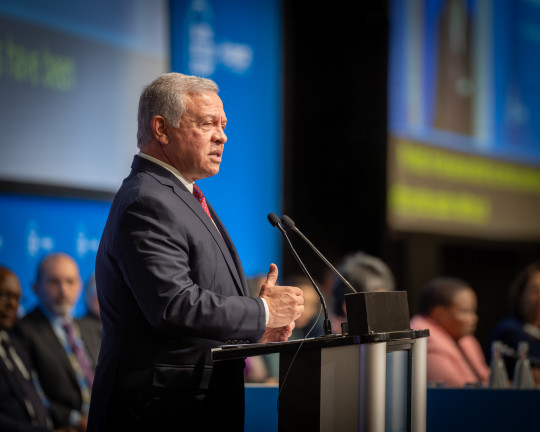

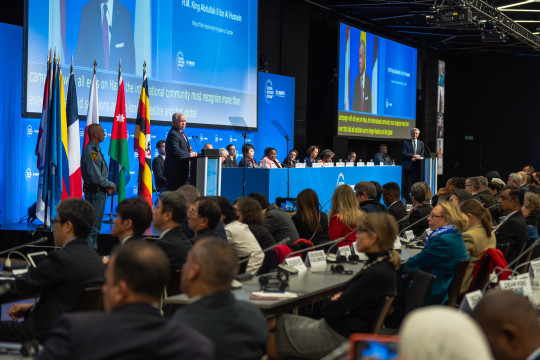
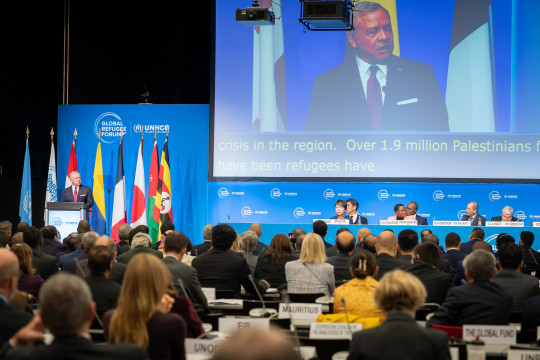

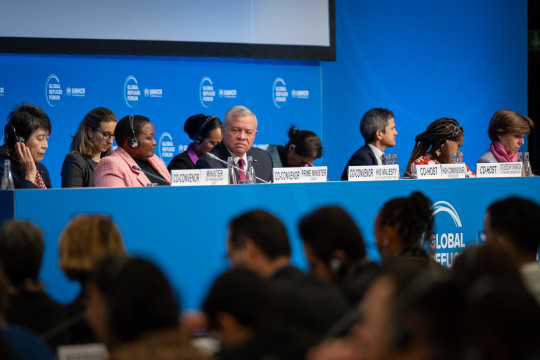

13 December 2023: King Abdullah II delivered the keynote address at the Global Refugee Forum in Geneva, co-convened by Jordan, Colombia, France, Japan and Uganda, and co-hosted by Switzerland and UNHCR.
His Majesty warned of the waning international attention to the ongoing refugee crisis.
“As serious crises compete for international attention, the plight of refugees and their host countries has taken a backseat. But this is a lapse that the international community can ill afford,” the King said.
“And now, as we speak, we find ourselves dealing with another internal displacement crisis in the region. Over 1.9 million Palestinians in Gaza, many of whom are themselves refugees, have been forced to flee their homes amid a relentless bombing campaign,” His Majesty said.
“With all eyes on Gaza, the international community must recognise, more than ever, that band-aid solutions are no longer feasible, and that global crises demand long-term responsibility-sharing,” the King added.
His Majesty said Jordan is pushing for a more coordinated humanitarian response in Gaza, and supporting the Palestinians and UNRWA “in any way we can”.
“But our country is still bearing the heavy costs and burdens of the refugee communities in our midst,” the King added, urging the international community not to leave the most vulnerable behind.
Following is the full keynote address by His Majesty:
“In the name of God, the Compassionate, the Merciful
High Commissioner Grandi,
Your Excellencies,
My Friends:
I would like to thank Switzerland and the UNHCR for co-hosting this forum. And my thanks also to our fellow co-convenor nations for recognising the need to bring the spotlight back to a major global issue, an issue Jordan is all too familiar with.
Jordan hosts nearly 4 million refugees of different nationalities, including almost 1.4 million Syrians. All in all, this is over a third of our 11 million population.
In an increasingly volatile region, welcoming refugees has become an indelible part of Jordan’s national identity. We cannot turn our backs on refugees, because that is who we are.
But Jordanians have been increasingly feeling that the world is turning its backs on them, as refugee hosts.
As serious crises compete for international attention, the plight of refugees and their host countries has taken a backseat. But this is a lapse that the international community can ill afford.
My friends,
Just a few months ago, I stood before the UN General Assembly and urged the world not to forget Syrian refugees.
And now, as we speak, we find ourselves dealing with another internal displacement crisis in the region. Over 1.9 million Palestinians in Gaza, many of whom are themselves refugees, have been forced to flee their homes amid a relentless bombing campaign.
With all eyes on Gaza, the international community must recognise, more than ever, that band-aid solutions are no longer feasible, and that global crises demand long-term responsibility-sharing.
Jordan is pushing for a more coordinated humanitarian response in Gaza. We are supporting the Palestinians and UNRWA in any way we can. But our country is still bearing the heavy costs and burdens of the refugee communities in our midst.
And let us be clear about the scope. In Jordan, UNRWA registers 2.3 million refugees; UNHCR registers more than 730,000 others; and nearly a million more are not covered by either agency.
International partners are essential, and our response plan for the Syrian refugee crisis has been world-recognised, yet, it has never been fully funded. Indeed, international funding to meet pledges has been steadily declining. So far this year, we only received around 22 percent of the response plan’s needs—the lowest level ever.
The rest is covered through Jordan’s national budget. This has raised the challenge of additional expenditures, and placed even more pressure on our strained resources, especially water, as we struggle to cope with the dual impact of the refugee crisis and climate change.
With one of the lowest water shares per capita in the world already, the challenge of covering the water needs of our people, as well as refugees, has become extremely dire. One vital mega-project we are hoping will alleviate this emergency envisions desalinating Red Sea water from the Gulf of Aqaba, and supplying it to major population areas.
And we remain committed to providing refugees with education at our schools, medical services at our hospitals, and access to livelihood opportunities, but sufficient funds are key to enable us to continue providing basic services.
With no clear long-term commitments in flexible international funding, the vulnerability of refugees and Jordanian host communities will grow even more precarious.
And the severe shortfall in funds for key agencies like the World Food Programme and UNHCR is negatively affecting the level of services, including cash assistance, education, and healthcare.
After cuts in World Food Programme assistance to vulnerable refugees this year, a deterioration in food security and self-reliance has become a painful reality for the vast majority, with 91 percent now being food insecure, compared to 63 percent before the cuts.
So my friends,
For many years, we and other host countries have been offering shelter, education, healthcare, jobs, and resources to refugees at a great cost to our own economic progress.
But we recognise that this is a long-term commitment that we are undertaking on behalf of the international community.
And likewise, the international community cannot resort to short-term solutions and move on to the next crisis.
Jordan has often warned of the dangers of leaving a lost generation behind, yet, instead of making headway in resolving this ever-evolving and expanding refugee crisis—and even as new displacement crises emerge—we see attention waning.
We cannot afford for this to continue. Our global community cannot thrive if its most vulnerable are left behind.
Let’s make this forum count.
Thank you.”
2 notes
·
View notes
Text
Empowering Women and Girls through Thirst Relief
Water is a fundamental necessity for all living beings, yet millions of people around the world lack access to clean and safe water sources. The global water crisis disproportionately affects women and girls, who often bear the burden of fetching water for their families, sacrificing their education, health, and overall well-being. In this blog, we will explore how organizations like Penny Appeal USA are empowering women and girls through thirst relief initiatives, providing them with access to clean water and transforming their lives in the process.

The Water Crisis and its Impact on Women and Girls:
Across the globe, approximately 2.2 billion people lack access to safe drinking water, and about 4.2 billion people lack adequate sanitation facilities. The ramifications of this crisis are particularly severe for women and girls, who face various challenges due to their traditional roles and responsibilities.
One of the most significant challenges is the time and effort spent on fetching water. In many communities, women and girls are responsible for traveling long distances to collect water from contaminated sources, exposing them to health risks and preventing them from pursuing education and other opportunities. The daily struggle for water perpetuates the cycle of poverty and gender inequality.
Empowering Women and Girls through Thirst Relief:
Penny Appeal USA recognizes the importance of addressing the water crisis from a gender perspective and has developed comprehensive programs to empower women and girls through thirst relief initiatives. By providing access to clean water, these initiatives aim to break the barriers that prevent women and girls from reaching their full potential. Here are some key ways in which Penny Appeal USA is making a difference:
Water Wells and Infrastructure: Penny Appeal USA constructs water wells, boreholes, and water infrastructure in communities affected by water scarcity. These projects significantly reduce the distance and time spent collecting water, allowing women and girls to invest their time in education, income-generating activities, and personal development.
Sanitation and Hygiene Education: In addition to water provision, Penny Appeal USA promotes sanitation and hygiene education. Women and girls are educated on proper sanitation practices, menstrual hygiene management, and the importance of handwashing. By equipping them with knowledge, Penny Appeal USA enables women and girls to lead healthier lives and maintain their dignity.
Economic Empowerment: Penny Appeal USA supports income-generating projects that focus on water-related activities, such as water filtration systems and small-scale water businesses. These projects create opportunities for women to earn a sustainable income, contributing to their economic empowerment and breaking the cycle of poverty.
Advocacy and Awareness: Penny Appeal USA raises awareness about the water crisis and its impact on women and girls, advocating for change at local, national, and international levels. By amplifying the voices of marginalized communities, Penny Appeal USA promotes policy reforms and greater investment in sustainable water solutions.
The Ripple Effect of Empowerment:
The impact of Penny Appeal USA’s efforts goes beyond the provision of clean water. Empowering women and girls through thirst relief initiatives has a ripple effect on entire communities. When women are no longer burdened by the arduous task of water collection, they have more time to engage in income-generating activities, pursue education, and contribute to community development. The education and opportunities afforded to girls break the intergenerational cycle of poverty, empowering them to become agents of change in their own right.
Access to clean water is a basic human right, and Penny Appeal USA is at the forefront of empowering women and girls through thirst relief initiatives. By addressing the unique challenges faced by women and girls in water-scarce regions, Penny Appeal USA is transforming lives, promoting gender equality, and creating sustainable change. Together, let us support these crucial initiatives and work towards a world where every woman and girl has the opportunity to thrive, unencumbered by the burden of water scarcity.
2 notes
·
View notes
Text
𝐒𝐂𝐈𝐄𝐍𝐂𝐄 𝐅𝐈𝐂𝐓𝐈𝐎𝐍 𝐒𝐓𝐎𝐑𝐘
I am Cristine, and 1,825 days have passed since the catastrophic tragedy that forever changed our planet. The chaos started 5 years ago, specifically on Tuesday, March 18, 2031, where it all happened. During the morning, I was at work with my husband Elkin, around 10 a.m., when I heard the news. So, my husband and I left work in search of water. The streets of my city were already filled with people in panic and fear of running out of the most vital resource for living.
Subsequently, the government declared that it was taking measures to address the crisis. News reports of water shortages and natural resources were causing the inhabitants to collapse. Then, desperate to do something, I took my agenda and started to carry out my plan. "Aqua Time Saver". Elkin, my husband, who is a programmer and engineer, helped me with my plan. After numerous attempts, Elkin gives up and experiences a recurrence of his discouragement, as the situation seems to have no solution. However, I persevered and told him:
—Don't get discouraged; that doesn't allow you to think clearly.
—I'm not discouraged! -said Elkin.
—Yes, you are. -I replied
—Very well, I am, what else can I do?" answered Elkin.
—Have a chocolate to cheer you up. You can do it, just be patient; I'm sure you will!
Thanks to my efforts to encourage Elkin, he finally found a way to get the time machine working. Consequently, the machine had been turned on, and without thinking about it, Elkin and I went into the past to avoid tragedy. First, we use the machine to go back to the year 2023. With our experiences of the future, we work tirelessly to convince world leaders and society about the importance of water conservation. Also, we created a global network of scientists, engineers, and activists focused on solving the water crisis. As the years passed, our actions paid off. People created videos on how to save water; even kindergartens started to teach the children how to conserve water.
Finally, we returned to the year 2036, where we look to a future where the catastrophe of March 18, 2031, is only a memory of a past that never happened. Indeed, the Earth has been saved, and the lesson of the importance of water conservation remains a fundamental part of our society.

How did I create the AI images?
To create images with artificial intelligence, you need to search for an AI generator online, enter specific details in its user interface to get the desired image, adjust additional options if necessary, and then click "generate" to get the image.
VIDEO
4 notes
·
View notes
Text
Sir Patrick Vallance is the UK government’s chief scientific adviser
The relationship between humans and nature is under intense and increasing strain. The report released today by Ipbes, the Intergovernmental Science-Policy Platform on Biodiversity and Ecosystem Services (akin to the IPCC reports on climate change), provides compelling evidence that humans are overexploiting wild species and habitats. Harmful activities, including habitat destruction, poor farming practices and pollution, have altered ecosystems significantly, driving many species past the point of recovery. In Great Britain alone, of the 8,431 species assessed in the 2019 State of Nature report, 1,188 are threatened with extinction. Globally, there are an estimated one million at risk, with biodiversity declining at a faster rate than at any time in human history.
We cannot ignore biodiversity loss. Biodiversity is the variability that exists among all living organisms, between different species, within species including genetic makeup, and in wider ecosystems. Billions of people rely on wild species for food, clean water, energy, income and health and wellbeing. Annually, crops worth up to £480bn are pollinated by a variety of wild animals, and an estimated 4 billion people depend on natural medicines for their healthcare. These vital ecosystem services are fundamentally based on a healthy environment, and this requires biodiversity. Losing biodiversity leaves species and ecosystems less resilient to challenges such as invasive species or pests, meaning there is an increased risk of whole populations being wiped out and destabilising the entire ecological network. Nature is a finite resource, and human self-interest alone should determine that biodiversity must be protected.
Alongside overexploitation, humans are driving biodiversity loss by destroying, polluting and fragmenting habitats across the globe. Many of the UK’s important peatlands, which provide a home for rare species such as the hen harrier, have been drained for agricultural use. The Amazon rainforest is being cleared to such an extent that it may be near a tipping point beyond which it cannot recover.
The climate crisis is exacerbating the issue. Many species simply cannot adapt to the scale and pace of changing temperatures. For example, warming seas and ocean acidification are devastating coral reefs around the world. This year, the Great Barrier Reef suffered its sixth mass bleaching event since 1998 with more than 90% of reefs affected. In many cases, when an ecosystem loses biodiversity, it becomes less able to store carbon, contributing to further climate change. We have a vicious cycle: climate change leads to biodiversity losses, which in turn leads to further climate change. As governments around the world develop plans to reduce carbon emissions and conserve biodiversity, the message isthe message is simple: we must solve both problems together.
What can be done? Just as science has diagnosed the problem, it can provide solutions. Using strong evidence, such as this Ipbes report, governments can develop effective policy. Integrated and collaborative planning can deliver sustainable solutions which address climate change and biodiversity loss simultaneously, protecting and enriching human lives.
In southern India, scientists, Indigenous communities and local government have worked collaboratively to protect and restore mangrove forests. The trees’ interconnecting large-root systems offer protection against rising sea levels, provide habitats for fish and crustaceans, and clean surrounding water. The trees also draw and store carbon from the atmosphere and encourage carbon-rich sediment deposits. The increase in wildlife has benefited small scale fisheries and tourism. Innovative and effective nature-based initiatives such as these could be implemented throughout different landscapes across the planet.
There are also simple day-to-day things we can do to benefit our environment; for instance, reducing food waste. Currently about 30% of all food produced globally goes uneaten, meaning a significant proportion of the resources, and importantly the land used to grow, process, pack and transport it, is wasted and less able to support biodiversity.
Political will and leadership are needed, and the 15th UN Convention on Biological Diversity conference in December, CBD Cop15, provides the next critical opportunity for governments to commit to real ambitious change.
CBD Cop15 could deliver landmark action and be as important for biodiversity as the Paris Agreement is proving for reducing greenhouse gas emissions. It will set the direction for the next decade of international action and beyond. Governments should agree to halt and reverse biodiversity loss by 2030, and develop evidence-based, actionable plans to do so. An important challenge is to define a reliable and simple integrated metric, like carbon emissions have been used for climate goals. At the end of June, negotiators met in Nairobi for their latest attempt to agree the Post-2020 Global Biodiversity Framework, and while progress was made, it did not go far enough.
The last decade’s targets were not met; the next decade’s must be. Credible delivery plans will be required, and we need a robust mechanism for monitoring progress and holding ourselves to account. CBD Cop15 is the time to finalise the framework, and countries must come to the table prepared to make and support ambitious commitments. This is our chance to secure long-lasting agreements to protect our planet.
#biodiversity loss#overexploitation#tipping points#climate change#amazon rainforest#fishing#agriculture#ipbes#great barrier reef
34 notes
·
View notes
Text
"Preparing for a Global Environmental Catastrophe: Creative Expansion"

In light of the imminent global ecological catastrophe, recent developments near the city of Armyansk have raised concerns. Reports from the Kherson Regional State Administration indicate that Russian individuals have allegedly initiated the process of sabotaging the Crimea Titan plant, situated in close proximity to the city. This action is purportedly aimed at thwarting the counteroffensive operations of the Ukrainian Armed Forces on the peninsula. Furthermore, Russia intends to shift blame onto the Ukrainian side for the consequences of this criminal act. If the occupiers resort to such terrorist actions, environmental experts predict that a poisonous cloud of emissions may engulf Ukraine, Turkey, and even parts of Russia itself. It is important to note that the Crimea Titan plant is the largest producer of titanium dioxide in Eastern Europe.
Amidst the escalating global environmental crisis, nations around the world are grappling with the urgent need for sustainable solutions. The incident involving the Crimea Titan plant serves as a chilling reminder of the potential ramifications that destructive actions can have on both regional and international levels. Beyond its immediate political implications, this act of sabotage has far-reaching ecological consequences that demand our attention.
The Crimea Titan plant, renowned as the preeminent producer of titanium dioxide in Eastern Europe, holds significant industrial and economic importance. Titanium dioxide is a versatile compound used in various industries, including paint, cosmetics, and plastics. The plant's massive production capacity underscores its crucial role in supplying this essential component to meet the demands of numerous sectors.
However, the dark cloud of environmental devastation looms over this dire situation. If the perpetrators succeed in their nefarious plot, the release of toxic emissions from the sabotaged plant could trigger an ecological disaster of unprecedented magnitude. The potential fallout extends beyond the immediate vicinity, with Ukraine, Turkey, and even parts of Russia at risk of being engulfed by the poisonous cloud.
The consequences of such an event would be catastrophic, with far-reaching implications for human health, ecosystems, and the delicate balance of our planet. The toxic cloud could permeate the atmosphere, causing respiratory ailments, contaminating water sources, and decimating wildlife populations. The long-term effects on the affected regions would be immeasurable, with lasting damage to biodiversity, agriculture, and local economies.
Recognizing the gravity of this situation, global attention must be directed towards preventive measures and collaborative efforts to avert this potential catastrophe. It is imperative that the international community comes together to condemn such acts of environmental terrorism and holds the responsible parties accountable for their actions.
Moreover, this incident underscores the pressing need for a paradigm shift in our approach to environmental protection. As we confront the consequences of climate change and face the specter of global ecological collapse, it is crucial that we prioritize sustainable practices, invest in renewable energy sources, and foster international cooperation in addressing environmental challenges.
he reported attempt to sabotage the Crimea Titan plant near Armyansk serves as a sobering reminder of the grave threats posed by actions driven by political agendas. Beyond the immediate security concerns, the potential environmental repercussions of such an act demand our attention. The prospect of a toxic cloud enveloping Ukraine, Turkey, and parts of Russia underscores the urgency of taking decisive action to prevent this ecological catastrophe. Only through collective effort and a commitment to sustainable practices can we safeguard our planet and ensure a brighter future for generations to come.
#Global environmental catastrophe#Ukraine-Russia tensions#Ecological disaster#International cooperation
3 notes
·
View notes
Text
By Oliver Milman
The Guardian
June 30, 2022
The US supreme court has sided with Republican-led states to in effect hobble the federal government’s ability to tackle the climate crisis, in a ruling that will have profound implications for the government’s overall regulatory power.
In a 6-3 decision that will seriously hinder America’s ability to stave off disastrous global heating, the supreme court, which became dominated by rightwing justices under the Trump administration, has opted to support a case brought by West Virginia that demands the US Environmental Protection Agency (EPA) be limited in how it regulates planet-heating gases from the energy sector.
The case, which was backed by a host of other Republican-led states including Texas and Kentucky, was highly unusual in that it was based upon the Clean Power Plan, an Obama-era strategy to cut emissions from coal-fired power plants that never came into effect. The Biden administration sought to have the case dismissed as baseless given the plan was dropped and has not been resurrected.
Not only was this case about a regulation that does not exist, that never took effect, and which would have imposed obligations on the energy sector that it would have met regardless. It also involves two legal doctrines that are not mentioned in the constitution, and that most scholars agree have no basis in any federal statute.
However, the supreme court has sided with West Virginia, a major coal mining state, which argued that “unelected bureaucrats” at the EPA should not be allowed to reshape its economy by limiting pollution – even though emissions from coal are helping cause worsening flooding, heatwaves and droughts around the world, as well as killing millions of people through toxic air.
“Capping carbon dioxide emissions at a level that will force a nationwide transition away from the use of coal to generate electricity may be a sensible ‘solution to the crisis of the day’,” wrote Chief Justice John Roberts in the opinion. “But it is not plausible that Congress gave EPA the authority to adopt on its own such a regulatory scheme in Section 111(d). A decision of such magnitude and consequence rests with Congress itself, or an agency acting pursuant to a clear delegation from that representative body.”
Roberts was joined by the conservative justices Samuel Alito, Neil Gorsuch, Brett Kavanaugh and Amy Coney Barrett. The three liberal justices, Sonia Sotomayor, Elena Kagan and Stephen Breyer dissented. It is the most important climate change case to come before the supreme court in more than a decade.
But the ruling could also have sweeping consequences for the federal government’s ability to set standards and regulate in other areas, such as clean air and water, consumer protections, banking, workplace safety and public health. It may prove a landmark moment in conservative ambitions to dismantle the “regulatory state”, stripping away protections from Americans across a wide range of areas.
It could fundamentally change what the federal government is and what it does. And, as justice Elena Kagan pointed out in her dissent, it could leave technical decisions to a political body that may not understand them.
“First, members of Congress often don’t know enough – and know they don’t know enough – to regulate sensibly on an issue. Of course, members can and do provide overall direction. But then they rely, as all of us rely in our daily lives, on people with greater expertise and experience. Those people are found in agencies,” she wrote.
Several conservatives on the court have criticized what they see as the unchecked power of federal agencies, concerns evident in orders throwing out two Biden policies aimed at reducing the spread of Covid-19.
Last summer, the six-to-three conservative majority ended a pandemic-related pause on evictions over unpaid rent. In January, the same six justices blocked a requirement that workers at large employers be vaccinated or test regularly for the coronavirus and wear a mask on the job.
The Biden administration was supported in the EPA court case by New York and more than a dozen other Democratic-led states, along with prominent businesses such as Apple, Amazon and Google that have called for a swift transition to renewable energy.
The administration has vowed to cut US emissions in half by the end of this decade but has floundered in its attempts to legislate this outcome, with a sweeping climate bill sunk by the opposition of Republican senators and Joe Manchin, the centrist Democratic senator from West Virginia.
The federal government also had the power of administrative regulations in order to force reductions in emissions but the supreme court ruling will now imperil this ability.
5 notes
·
View notes
Text
Creating alternate climate realities: big ideas come from small towns
“So many of us come together to mobilize, make waves, and share space- to feel some agency within a machine that has cogs in nearly every aspect of our day-to-day lives. Everyone looks to one another hoping for the right answer (and also hoping to make that answer first), aiming to deduce the best tactic, the elusive “silver bullet” to stop or at least slow down the crisis that fills us with anxiety. Underlying much of our movement is a fundamental survival mechanism that operates on “me” instead of “we”.
Far too much of our collective energy is directed toward a pursuit that leaves us mirroring capitalism, individualism, and that which we fight. Bringing in more people (and ultimately more dollars) seems to be the only acceptable theory of change. Money-the currency of individualism-hangs like a heavy cloud over campaigns calling for systemic change. It is undeniable we are all stuck in the clutches of capitalism and the fossil fuel economy, from the tiny collective to the global environmental NGO. Creating educational materials, conducting research, bringing lawsuits, etc.- it costs money. But there are millions of people who are waiting for direction on how to protect our shared home. These times are indeed urgent, as all of our messaging states. We can do far better to direct the energy of those already engaged into substantive change.”
Excerpt from Tara Houska’s essay, Sacred Resistance, in All We Can Save: Truth, Courage, and Solutions for the Climate Crisis.
This excerpt tells the reader very clearly: community scale action must be prioritized. It is easy to get caught up in daily life, while trying to at least contribute your little grain of sand (“tu granito de arena”) to the sea of possible actions for mitigating the climate crisis, but that is exactly what our current system hopes for. This system hopes that the most we can do is to stop eating meat, stop single-use plastic, and buy from thrift stores. At the scale of the fossil fuel industry, this is less than significant, but let me be clear: this is not to say that people should take small-scale action, but that these individualized actions leave people satisfied, and so they don’t seek further, larger-scale action.
I would love to say that we can change institutions from the inside, but if this is possible, this change will be slow. What we can do now is rely on each other and take these actions into our own hands. In cases when the local government clearly will not take action, I would like to see collective action solving these issues, as has occurred already in vulnerable communities across the globe. Casa Pueblo speaks of creating a new reality for Puerto Rican communities, a reality that doesn’t depend on the lack of reaction from the political leaders that the town leans on. A look into the future occurred after Hurricane María, as Casa Pueblo created a bubble of an alternate reality. This reality of solar-powered homes and businesses allowed the town of Adjuntas to have electricity throughout an island-wide blackout. Now, imagine this reality, but instead of within just a bubble, it has spread to the entire island. Small Island States (SIDS) would greatly benefit from the use of the wind, solar, and ocean resources, especially in the midst of climate disaster. These islands are often left without resources, such as electricity, food, and water, but if their natural resources are harnessed before, during, and in the aftermath of a hurricane, for example, the island community immediately doubles and even triples its resilience to these events. This is a reality that we’ve seen sampled, in smaller bite-sized realities, and it is time to expand beyond the current infrastructure. The people have the power to enact this change, but it won’t be easy.
0 notes
Text
Go Green: Grab Our Free Presentation Template of Environment and Climate Change

In today's world, the pressing issues of environmental degradation and climate change have become more critical. As individuals and businesses strive to adopt sustainable practices, effective communication and education play crucial roles. To aid in this effort, we are excited to offer a free presentation template of Environment and Climate Change. Let's delve into how this template can help you create impactful presentations on these vital topics.
Introduction: Understanding the Urgency
The introduction sets the stage by highlighting the urgent need for action regarding environmental preservation and climate change mitigation. It provides an overview of the key challenges we face, such as rising global temperatures, deforestation, pollution, and their far-reaching impacts on ecosystems and human life. This section aims to create awareness and a sense of urgency among the audience.
Exploring Environmental Issues
In this section, we delve deeper into specific environmental issues that the presentation template covers. Topics may include air and water pollution, biodiversity loss, waste management, sustainable agriculture, and renewable energy. Each subtopic is accompanied by relevant data, visuals, and insights to educate the audience about the complexities of these challenges.
Understanding Climate Change
The focus shifts to climate change, elucidating its causes, effects, and potential solutions. This section discusses greenhouse gas emissions, global warming trends, extreme weather events, sea-level rise, and the impact on ecosystems, economies, and human health. It also emphasizes the importance of climate action and the role of individuals, businesses, and governments in combating this crisis.
Advocating Sustainable Practices
The final section encourages action and advocacy for sustainable practices. It offers practical tips, strategies, and initiatives that individuals and organizations can adopt to reduce their environmental footprint and contribute to a greener, more sustainable world. This includes promoting renewable energy adoption, waste reduction, conservation efforts, sustainable transportation, and supporting policies for environmental protection.
Why Use Our Presentation Template?
Our free presentation template on Environment and Climate Change offers several advantages:
Visual Impact: The template features visually appealing designs, graphics, and animations that enhance engagement and retention.
Data Visualization: It includes charts, graphs, and infographics to present complex data and statistics in a clear, digestible manner.
Customization: Users can easily customize the template to align with their specific content, branding, and messaging needs.
Educational Resource: It serves as an educational resource for schools, NGOs, businesses, and individuals to raise awareness and drive positive change.
Conclusion: Empowering Change Through Education
In conclusion, our free presentation template on Environment and Climate Change is a powerful tool for educating and inspiring action. By leveraging compelling visuals, informative content, and a call to action, presenters can effectively communicate the importance of environmental stewardship and climate resilience. Together, let's go green, raise awareness, and work towards a sustainable future for generations to come.
0 notes
Text
Water Infrastructure and Repair Technologies: Closing the Gap

As per United Nations Environment Programme, more than 3 billion people globally are at risk of disease due to hazardous water quality in rivers, lakes, and groundwater. Moreover, the water availability in a 5th of the world's river basins is experiencing significant fluctuations, exacerbating the water crisis. Therefore, water infrastructure and repair technologies play a crucial role in the proper functioning of water delivery systems, resource management, flood protection, and other critical applications.
The global water infrastructure and repair technology market is expected to gain $165096.73 million by 2030, growing at a CAGR of 6.49% during the forecast period 2023-2030. The global surge in population and the consequent influx in water demand have propelled significant growth in the market.
According to a recent study by the United Nations Environment Programme, approximately 80% of the world's wastewater remains untreated, comprising various contaminants such as organic human waste and hazardous industrial discharges.
The need to ensure efficient and reliable operation of water infrastructure systems has led manufacturers to develop advanced technological devices. WIRT solutions minimize water loss and contamination, and provide safe and reliable access to water for communities, industries, and businesses, ensuring the sustainability of water resources.
The category segment of the market includes assessment, replacement, rehabilitation, and spot repair. In 2022, the replacement category dominated the market with a revenue of $38898.63 million.
However, high operating expenses associated with the equipment is the key challenge to the operating players. Maintenance costs, plant monitoring costs, energy costs, and pollution charges can significantly influence the operational expense. In particular, the high operational cost of a water treatment facility can contribute significantly to the annual cost.
For wastewater systems, operation, maintenance, and monitoring of a wastewater treatment plant can amount up to 50% of the annual costs. To give an example, Veolia Group's increasing debt levels have resulted in the company having to allocate a significant portion of its cash flow from operations toward the payment of principal and interest on its loans, which reduces the availability of funds for other areas of the business such as working capital, capital expenditures, and acquisitions.
WIRT Innovation in Water and Energy Sectors
The global population is rapidly increasing, leading to widespread urbanization and a surge in demand for energy fuels, including petrol, natural gas, and kerosene. As a result, refineries are expected to increase their output to meet this growing demand. Incorporating water treatment in refineries has the prime objective of reducing utility costs and making water available for captive electricity production. For instance, The Port Arthur Refinery in Texas, one of the largest refineries in the US, implemented a water treatment program that treats wastewater using advanced technologies such as reverse osmosis.
Manufacturers in North America are exerting themselves to match the burgeoning requirement for municipal and industrial water infrastructure, as well as repair technology applications. Also, governments in the region are initiating steps to upgrade the water infrastructure system by introducing new incentives. The Canadian Government has initiated the Clean Water and Wastewater Fund (CWWF) which provides short-term funding of $2 billion. The program initiatives are to improve water treatment and water distribution infrastructure systems.
As per our estimates, the North America water infrastructure and repair technology market is full of untapped opportunities waiting to be explored and is expected to grow at a CAGR of 6.82% during the forecast period of 2023-2030.
From Scarcity to Sustainability: The Promising Future of Water Industry
With groundwater being exploited at an alarming rate, freshwater depletion has become a critical issue. The impact is witnessed across sectors, including agriculture, which is heavily reliant on water resources. The severity of the situation necessitates prompt action to promote water infrastructure and repair technologies (WIRT) that can help conserve, manage, and recycle water resources.
Few Notable Examples:
Coca-Cola, the global beverage company, uses advanced water treatment systems in its bottling plants to recycle and reuse wastewater, reducing its dependence on freshwater sources.
Intel Technology Company has invested in a water reuse system in its manufacturing plants, which treats and recycles wastewater for use in cooling towers and other processes.
Levi Strauss & Co, the global apparel company has implemented a water recycling program in the textile manufacturing process, which treats and recycles wastewater for reuse in textile dyeing and finishing processes.
FAQs:
1. What major hurdle does the analyzed market encounter?
The high operating costs are affecting the growth of the market for water infrastructure and repair technology.
2. What is the estimated value of the Global Water Infrastructure Repair Market?
According to Triton Market Research’s report, the water infrastructure and repair technology industry, with a valuation of $99284.73 million in 2022, is projected to expand significantly and reach an estimated market size of $165096.73 million by 2030.
0 notes
Text
The United States made food security a top priority when it chaired the U.N. Security Council last month—and rightly so. Earth just experienced its hottest month in 120,000 years. Heat waves, droughts, and floods are killing off crops by the field full. Places such as Ethiopia, Afghanistan, and Haiti are gripped by worsening famine. In a blow to global food security, Russia recently backed out of the Black Sea grain deal that allowed Ukraine to export millions of tons every month. The geopolitics of nature have ushered in an era of unprecedented instability, and the worst is yet to come, with this year’s El Niño season predicted to persist through 2024.
To solve our mounting global food crisis, world leaders must look not only to the land, but to the waters as well—and to the often-forgotten and underappreciated source of vital nutrition known as blue foods.
The term “blue foods” is shorthand for food that comes from marine and freshwater ecosystems—from tunas, pollock, and cod to shrimp and seaweeds. Political attention and funding of blue food initiatives remain significantly underrepresented in national and global food discussions, despite the immense contribution that blue foods make to the health of people and economies around the world.
Blue foods support the livelihoods of more than 800 million people and remain among the most traded global commodities. Nearly half of humanity depends on the food group as a significant source of animal protein, vital micronutrients, and cultural identity.
Though producing some blue foods may have an inherently lower environmental footprint relative to cattle and other land-based livestock, there is not an endless supply. In our oceans alone, roughly 92 percent of our wild-caught fish comes from stocks that can’t handle additional fishing pressure or have already been overfished. The picture isn’t better for migratory freshwater fish, which have declined on average by 76 percent since 1970. With the demand for blue foods projected to nearly double by 2050, the math simply doesn’t add up to a stable future. Aquaculture, the farming of aquatic species, is an important part of the solution, but it can’t backfill the collapse of ocean fish populations or insulate the global economy from its consequences.
While resource conflicts are commonly thought of as a land-based challenge—for example, disputes over oil, minerals, or forestry—conflict over marine natural resources has always existed.
One study found that during the Cold War, 25 percent of military conflicts between democracies were over fisheries—and they have only been increasing ever since. Since the 1990s, more than 150 international fishery conflicts involving militaries have occurred, and five countries have been involved in 40 percent of them, with China and Russia leading the chart.
In China, the world’s largest fishing power, whose population consumes almost twice the global average of seafood per capita, the fisheries economy generates nearly $200 billion annually and employs millions of people. As such, fish are a strategic and critical resource for Beijing, and China has increasingly used legislative, economic, and military means to access and control the global supplies of seafood over the past 35 years. In the Horn of Africa, the past three decades have been rocked by more than 600 conflicts that have disrupted livelihoods, killed hundreds of people, and contributed to rampant piracy that has threatened maritime security.
Climate change will exacerbate all these trends. Warming waters are impacting fish reproduction and forcing species to migrate at unprecedented levels, creating newly fish-rich and fish-poor places. In the next seven years alone, 23 percent of fish stocks connected to territorial waters will move—including in waters near Canada, Britain, Norway, Iceland, and Japan. There will be winners and losers because of these shifts, spurring heightened competition for scarce resources that will intensify conflict between communities and countries.
When fish become harder to find, so too will peace and security. Small-scale fishery conflicts destabilize coastal communities, contributing to environments that foster greater crime, food insecurity, and poverty. Internationally, the risk of escalation from small, relatively innocuous conflicts on our oceans is growing, particularly in regions already grappling with maritime conflicts over borders and resources. Labor and human rights abuses are also pervasive in blue food value chains—half of all blue foods come from countries that the U.S. government has identified as having high risk of human trafficking.
We still have time to prevent the escalation of conflict and human rights violations, particularly when conservation and natural resource management offer the opportunity for cooperative engagement and protection of blue food resources.
First, climate science, oceans science, and political science can pinpoint where the greatest conflict pressures will emerge in the future—five to 10 to 30 years out. With access to this high-quality data, governments can deliver a new era of refined early warning systems and maritime security and conservation planning. This kind of information also makes it easier to prioritize and safeguard areas where crucial habitats, such as spawning and nursing grounds, contribute to a sustainable blue food supply.
To effectively manage and protect these areas, we must design inclusive conservation strategies that prioritize the needs and voices of coastal Indigenous peoples and local communities that are often on the front line of the climate crisis. These communities are the most vulnerable to changes in the environment and are highly dependent on seafood, with 15 times higher consumption per capita than non-Indigenous communities, on average. And case studies have shown that an inclusive approach can be beneficial to all. In Indonesia, for example, community involvement and equitable governance led to more fish in protected areas than in nonprotected areas.
Second, we need to improve local and global fishing practices through science-based fishery management that proactively plans for the impacts of climate change by strengthening oversight to bring about more sustainable and responsible fisheries. Fisheries that regulate the amount and location of fishing efforts depending on the present or projected health of fish stocks will be better placed to handle future threats. These practices must extend to small-scale fisheries, which contribute about 32 percent of overall global seafood nutrient supply.
Third, aquaculture of noncarnivorous species should be scaled up to supplement the increased demand on fisheries, as wild-caught fish are a finite resource. Currently, developing countries supply nearly all of aquaculture, making it a critical source of food and income for them. But because they are strapped for resources, environmental protection and regulation is often a lower priority. Thus, policies that support effective zoning and permitting in lakes, rivers, and coastal regions need to be reformed to ensure that production does not exceed the carrying capacity of these natural habitats.
Fourth, seafood businesses around the world have a critical role to play. Companies that sell imported blue foods—which constitute more than 80 percent of the seafood sold in America—need to be responsible for sourcing blue foods that are produced more sustainably and ethically. With their market leverage, seafood companies have the opportunity and responsibility to encourage better management of their source fisheries and aquaculture farms. This is especially critical for smaller island nations such as Kiribati and Tokelau, whose economies are both heavily dependent on seafood exports and are on course to lose fish stocks due to climate change.
Fifth, existing frameworks and agreements, including the U.N.’s Agreement on Port State Measures, which was the first binding international agreement to specifically target illegal, unreported, and unregulated fishing, must be strengthened and modernized to address the shifting environmental realities facing blue foods. Additionally, the world’s major fishing powers, including the United States and China, should support sustainable fisheries in the global south by eliminating harmful subsidies; last year, they took a step in the right direction with the adoption of the World Trade Organization’s Agreement on Fisheries Subsidies.
Continued multilateral cooperation and support for area-based management—the effort toward protecting, conserving, and restoring ecosystems—has the potential to advance solutions as well. A strong example is the Eastern Tropical Pacific Marine Corridor, a regional initiative led by Colombia, Costa Rica, Ecuador, and Panama, that aims to create an uninterrupted, sustainably managed biological corridor across more than 500,000 square kilometers (193,000 square miles).
Finally, we must catalyze robust partnerships across all sectors of society. Under U.S. President Joe Biden, the White House has convened private sector leaders around emerging challenges in strategic sectors, including semiconductors and artificial intelligence. The administration could similarly help rally U.S. and global seafood executives to source and supply the world with blue foods in a way that doesn’t squander the very resource that underwrites their business.
Blue foods aren’t a silver bullet—they’re a strategic commodity. When the bounty is plentiful, it can sustain hundreds of millions of livelihoods and billions of lives; when blue foods become scarce, it can drag communities, nations, and entire regions into violent conflict. The actions that the global community takes in the coming months and years will determine which path we take.
4 notes
·
View notes
Text

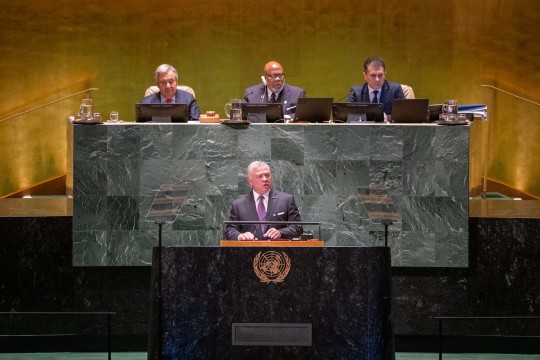
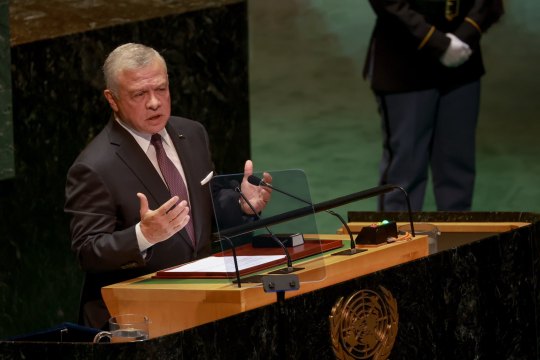
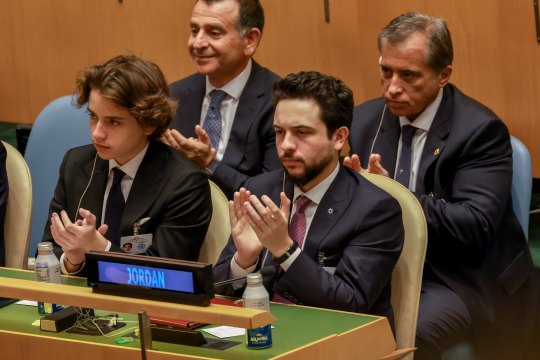
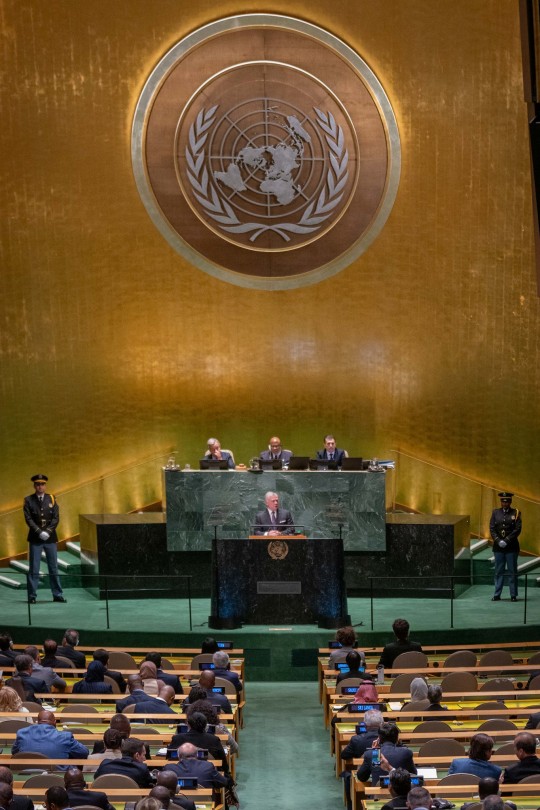
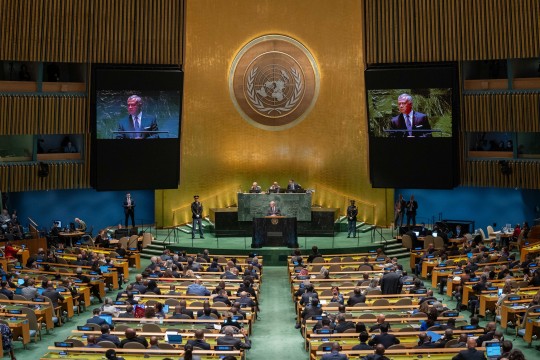
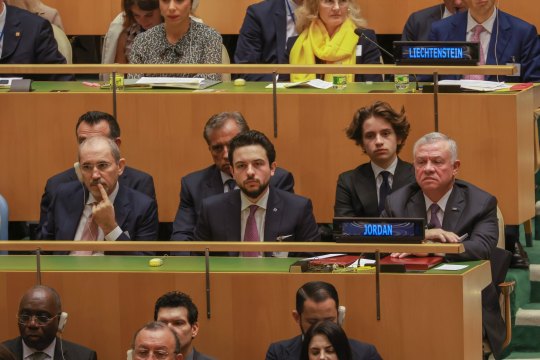
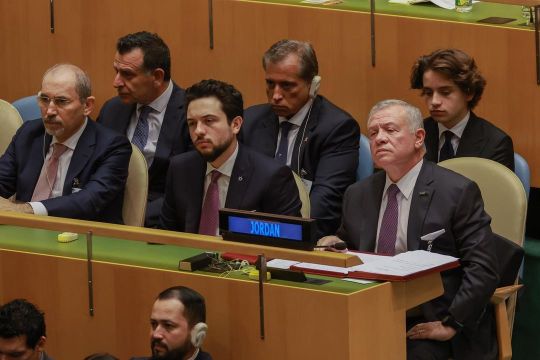
19 September 2023: King Abdullah II, accompanied by Crown Prince Hussein & Prince Hashem, participated in the 78th Session of the United Nations General Assembly in New York.
In an address to the General Assembly, he said Jordan will protect itself against any future threats that the Syrian crisis could pose to the Kingdom’s national security. He reiterated that Syrian refugees’ future is in their country, not in host countries.
Turning to the Palestinians cause, the King said that without clarity on where Palestinians’ future lies, it will be impossible to converge on a political solution to the conflict.
“How can people trust in global justice while settlement building, land confiscations, and home demolitions continue?” His Majesty asked, warning that the world must not abandon Palestinian refugees to the forces of despair.
The King said Jordan remains committed to safeguarding Jerusalem’s identity, under the Hashemite Custodianship of Islamic and Christian holy sites.
Noting the waning international attention towards refugees, His Majesty said, “Is the international community going to watch as refugee families find themselves forced to send their children to work instead of school?”
At the same time, His Majesty reaffirmed Jordanians’ seriousness about their duty to those in need, noting that they have done everything they can to secure a dignified life for refugees.
“We cannot allow for a lost generation on our watch,” the King warned.
Following is the full text of His Majesty’s speech:
“In the name of God, the Compassionate, the Merciful
Mr President,
Mr Secretary General,
Your Excellencies:
When human catastrophes seem beyond description, we turn to the appalling statistics.
This year, around the world, more than 345 million people face food insecurity, daily hunger, or starvation.
Among the most vulnerable are 108 million refugees, people who have been forcibly displaced from their homes and ways of life.
And forty percent of these refugees are children, the most defenceless of all.
Yet these numbers cannot really convey the tragedy—or the failure.
Refugees are our brothers, our sisters. They look to our countries to help end the crises that have driven them from home.
Refugees are mothers, fathers, grandparents, who have made perilous journeys to save their families.
They are young people with big dreams, and little children who deserve the chance to dream big.
They depend on the international community for their survival, and multiple UN agencies provide vital services to help meet the need.
But in recent months, one by one, these agencies have been delivering difficult news—a severe shortfall in international funds has forced them to cut support.
Is this what we’ve come to? Is the international community going to watch as refugee families find themselves forced to send their children to work instead of school?
In Jordan, where refugees make up over one third of our 11-million population, cuts have already thrown the lives of hundreds of thousands of refugees into uncertainty.
The impact of such humanitarian shortfalls is never limited to a country or a region. Fear and want bring on sharp increases in the number of refugees fleeing to Europe and beyond, on journeys that too often end in tragedy.
My Friends,
Jordanians are serious about our duty to those in need. We have done everything we can to secure a dignified life for refugees.
Nearly half of the almost 1.4 million Syrians we host are under 18 years of age. For many of them, Jordan is the only place they have ever known—over 230,000 Syrian children have been born in Jordan since 2011.
We are sharing precious resources to help them meet basic needs— food, energy, and especially, water. We are among the water-poorest countries in the world, even as our water supplies face extraordinary demand.
And we face these pressures just when another crisis has hit our region—climate change, with its destructive heatwaves, drought and flooding.
And to meet the refugee burden, we have been carefully managing to combine our limited resources with essential support from the international community. Because the responsibility to act falls on everyone’s shoulders. Because the world cannot afford to walk away and leave a lost generation behind.
But today, Jordan’s capacity to deliver necessary services to refugees has surpassed our limits.
Syrian refugees’ future is in their country, not in host countries. But until they are able to return, we must all do right by them.
And the fact is refugees are far from returning. On the contrary, more Syrians are likely to leave their country as the crisis persists.
And Jordan will not have the ability nor the resources to host and care for more.
We must find a political solution consistent with UN Security Council Resolution 2254. The step-for-step approach, offers a path forward. Proposed by Jordan as the basis for engagement with the Syrian government, and coordinated with the UN, this approach sets a roadmap to incrementally resolve the crisis and deal with all its consequences.
Until then, we will protect our country against any future threats the crisis could pose to our national security.
My Friends,
Jordan’s case is a microcosm of our entire region. For all our peoples’ immense potential, repeated crises have held back the promise of greater development and prosperity.
Our region is a focal point, where some of the most urgent global challenges are converging.
How will our world respond?
Will we come together in global solidarity, to get to the root of the problem: the conflicts and crises that destroy life and hope?
Will we work as one, to rebuild the lost trust in international action, and help those in want?
My Friends,
Our region will continue to suffer until the world helps lift the shadow of the Palestinian-Israeli conflict—the central issue in the Middle East.
No architecture for regional security and development can stand over the burning ashes of this conflict.
But seven and a half decades on, it still smoulders. Where are we going?
Without clarity on where Palestinians’ future lies, it will be impossible to converge on a political solution to this conflict.
Five million Palestinians live under occupation—no civil rights; no freedom of mobility; no say in their lives.
Yet every UN resolution since the beginning of this conflict recognises the equal rights of the Palestinian people to a future of peace, dignity, and hope. This is the heart of the two-state solution—the only path to a comprehensive, lasting peace.
We can see the Israeli people actively defending and engaging in the expression of their national identity. Yet the Palestinian people are deprived of that same right! To express and fulfil their own national identity! The basic requirement for that right is the establishment of their own independent and viable state, on the June 4th, 1967 lines, with East Jerusalem as its capital, living alongside Israel in peace, security, and prosperity.
And delaying justice and peace has brought endless cycles of violence—2023 has been the deadliest for the Palestinian people in the past 15 years.
How can people trust in global justice while settlement building, land confiscations, and home demolitions continue? Where is the global solidarity to make UN resolutions believable by people in need of our help?
Jerusalem is a flash point for global concern. Under the Hashemite Custodianship of Islamic and Christian holy sites, Jordan remains committed to safeguarding the city’s identity.
But preserving Jerusalem, as the city of faith and peace for Islam, Christianity, and Judaism, is a responsibility that we all share.
And we must not abandon Palestinian refugees to the forces of despair. Sustainable funding is urgently needed by UNRWA, the UN agency that provides vital relief, education, and health services to millions of Palestinian refugees. This is essential to protect families, keep communities stable, and prepare young people for productive lives.
We must protect young Palestinians from extremists who prey on their frustrations and hopelessness, by making sure they continue to learn at schools under the blue flag of the United Nations, as the alternative will be the black flags of terror, hate, and extremism.
My Friends,
We come together here as partners, to deal with our challenges and shape a better future.
We speak here for our people. We speak for families and the younger generations. We speak for victims of conflict, displacement, hunger, climate change disasters, and more.
They are not mere statistics. They are our fellow human beings, sharing our world. Only by restoring trust, only by acting in solidarity, will we create the future all our peoples desire and deserve.
We cannot allow for a lost generation on our watch.
Thank you”.
The Jordanian delegation at the 78th Session of the UNGA included Deputy Prime Minister and Foreign Minister Ayman Safadi, Director of the Office of His Majesty Jafar Hassan, and Jordan’s Permanent Representative to the UN Mahmoud Hmoud.
4 notes
·
View notes